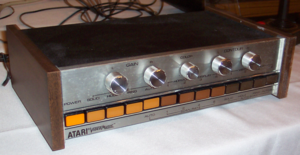
Atari Video Music
Encyclopedia

Atari, Inc
Atari, Inc. was an American video game and home computer company founded in 1972 by Nolan Bushnell and Ted Dabney. Primarily responsible for the formation of the video arcade and modern video game industries, the company was closed and its assets split in 1984 as a direct result of the North...
in 1976, and designed by the initiator of the home version of Pong
Pong
Pong is one of the earliest arcade video games, and is a tennis sports game featuring simple two-dimensional graphics. While other arcade video games such as Computer Space came before it, Pong was one of the first video games to reach mainstream popularity...
, Robert Brown. The idea was to create a visual exploration that could be implemented into a Hi-Fi stereo system. It is described in United States patent 4081829.
As the legend goes, when Atari was on tour promoting the device, a Sears representative asked what they were smoking when they invented it. With that, a technician stepped forward holding up a lit joint. Devo
Devo
Devo is an American band formed in 1973 consisting of members from Kent and Akron, Ohio. The classic line-up of the band includes two sets of brothers, the Mothersbaughs and the Casales . The band had a #14 Billboard chart hit in 1980 with the single "Whip It", and has maintained a cult...
used one as a background in the video for "The Day My Baby Gave Me A Surprise", as well as Daft Punk
Daft Punk
Daft Punk are an electronic music duo consisting of French musicians Guy-Manuel de Homem-Christo and Thomas Bangalter . Daft Punk reached significant popularity in the late 1990s house movement in France and met with continued success in the years following, combining elements of house with synthpop...
in their video "Robot Rock." The unit never gained enough popularity and was in production for only a year.
Features
The Video Music hooks up to a TV through an RF switchbox. The other hook ups are left and right RCA jack inputs that hook up to an audio amplifier's RCA outputs. The face is a brushed metalBrushed metal
Brushed metal is metal that has been abraded , usually with a fine grit sandpaper. The brushing gives the metal a distinctive look, as it retains some but not all of its metallic lustre and is given a pattern of very fine lines. It can be compared to metal with several small scratches all running...
plate and wood panel sides. The unit consists of 5 potentiometer knobs and 13 push-buttons. The way the audio generates the visual is in basic form a diamond in two parts. The outer part is the left audio channel while the right is the inner part.
The knob controls were as follows:
- Gain - 2 knobs controlling the left and right audio input signals strength.
- Color - 1 knob controlling. from a rainbow of colors to a solid color.
- Contour - 2 knobs controlling the left and right audio input signals visual representations shapes from soft to geometric.
The push button controls were as follows:
- Power - Turns unit on and off.
- Shape (solid) - Any imaged that is displayed will be solid
- Shape (hole) - One stereo channel controls the outside with a hole in the center controlled by the other stereo channel.
- Shape (ring) - Both stereo channels will represent 2 outline shapes that retain their thickness with the pulse of the music
- Shape (auto) - The system automatically cycles at random between the different Shape settings as well as the next 8 buttons:
- Horizontal 1 - Displays 1 generated image.
- Horizontal 2 - Displays 2 horizontal generated images
- Horizontal 4 - Displays 4 horizontal generated images
- Horizontal 8 - Displays 8 horizontal generated images
- Vertical 1 - Displays 1 generated image
- Vertical 2 - Displays 2 vertical generated images
- Vertical 4 - Displays 4 vertical generated images
- Vertical 8 - Displays 8 vertical generated images
The last 4 buttons have an auxiliary function when the "Auto" button is pushed. In this mode, the last 4 buttons represent Solid, Hole and ring. When the unit is in auto, it will retain the shape of one of those three shapes. The 4th button is "Auto All". This sends the unit into semi-automatic mode, cycling through shape, horizontal and vertical options but not affecting the gain, color or contour settings.

